Snakes are an important part of North Carolina’s ecosystem as they help control the population of pests such as rodents and slugs. North Carolina has 37 species of snakes. But before we get into the snakes of North Carolina, it is important to know the difference between venomous and nonvenomous snakes.
North Carolina’s venomous snakes are sometimes referred to as poisonous snakes. This is incorrect because snakes generate their venom and inject it into their prey. Because venom must be forcibly injected and poison is either absorbed or ingested (eaten), snakes are almost never poisonous.
Remember: If a snake bites a person and they die, the snake is venomous. But if a person eats a snake and dies, the snake is poisonous.
Luckily, out of the 37 species of snakes in North Carolina, only six are venomous. In this article, we’ll be taking a look at 6 Venomous Snakes in North-Carolina
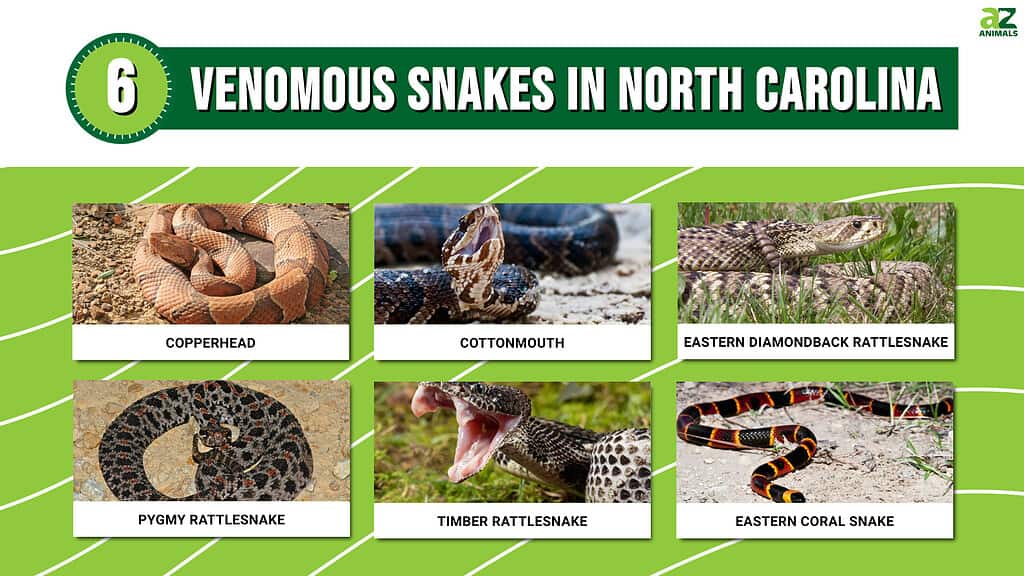
The 6 Venomous Snakes in North Carolina
Copperhead

Copperheads are venomous snakes mostly found in woodland areas.
©Creeping Things/Shutterstock.com
Copperheads are mostly found in North Carolina. These snakes are venomous and sometimes bite if they feel threatened. Their venom contains hemotoxins that damage tissues in the bite area. Luckily, the copperhead’s bite isn’t usually fatal, but can cause tissue death if not treated promptly.
Copperheads can grow to a maximum length of 36 inches. They are heavy-bodied snakes with large, triangular heads. They also have elliptical pupils, but you’ll only see those on any snake if the light is bright enough and you are close enough. These snakes give birth to babies and do not lay eggs.
Cottonmouth
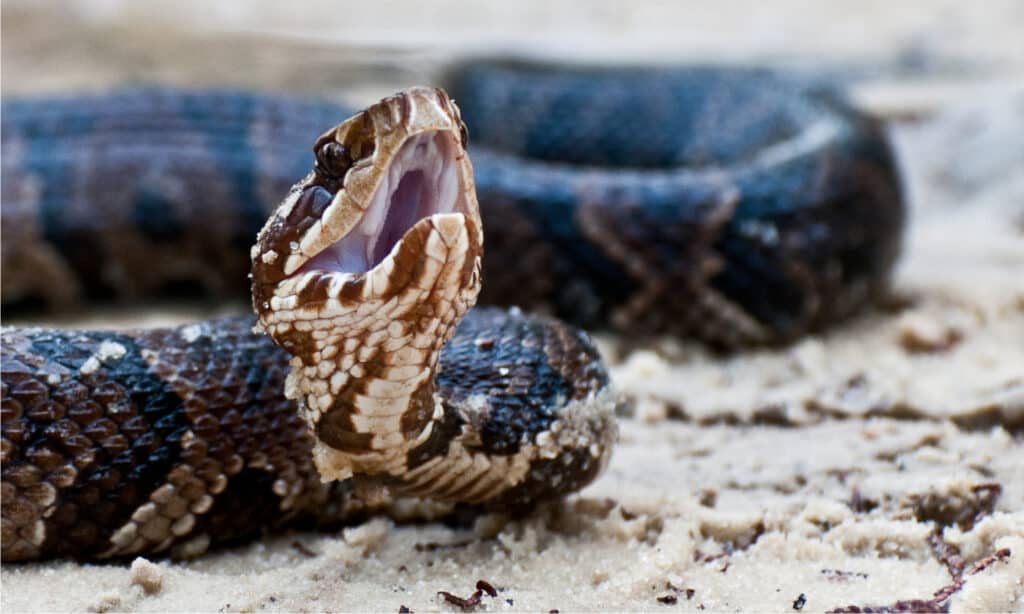
Also called water moccasins, cottonmouths are venomous semi-aquatic snakes.
©Jay Ondreicka/Shutterstock.com
Cottonmouths are the only venomous semi-aquatic snakes in North America. They spend most of their time in or near the water, primarily eating fish and frogs. However, they’ll also eat small turtles, lizards, and even other cottonmouths.
These snakes are usually easily identified because they have pixilated bands, dark eye stripes, and a distinctive defensive display. Cottonmouths also have large, angular heads and elliptical pupils typical of pit vipers. They’re born with bright greenish-yellow tails that young snakes use to lure prey closer. As cottonmouths mature, their once-bright tail color fades. Adult cottonmouths are colored yellowish-olive to darker shades of black and gray — their banding becomes nearly invisible in most adults.
These snakes’ venom contains hemotoxins that break down blood cells and stop blood from clotting. Although cottonmouth venom is usually considered less dangerous than an eastern diamondback rattlesnake, it is no joke. Cottonmouth venom, in the right dose, can kill humans. So, this is one snake you should admire from a difference.
Eastern Diamondback Rattlesnake
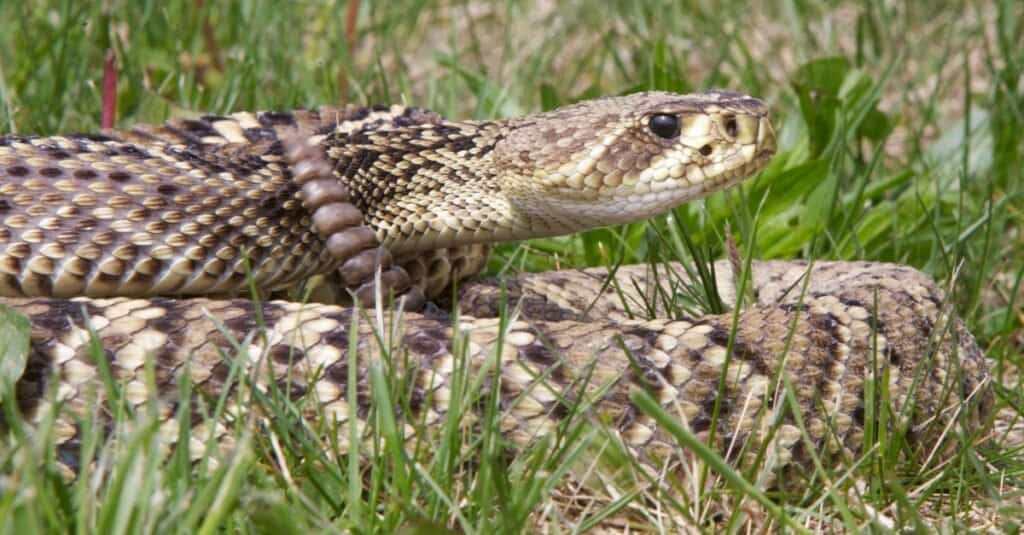
As the largest rattleback in the world, eastern diamondbacks can get huge — the heaviest was 34 pounds.
©iStock.com/NajaShots
Eastern diamondback rattlesnakes are highly venomous snakes with quick and painful bites that are often fatal to humans. Their venom contains hemotoxins which damage tissues and kill red blood cells. Not only are these snakes dangerous, they are also heavy — the largest eastern diamondback rattlesnake weighed 34 pounds.
Eastern diamondback rattlesnakes prefer rodents like rats, mice, and even rabbits. However, they also eat birds and anything else they can grab.
These venomous snakes often range from blackish-gray to muddy gray and even olive green. Their coloring makes it easy for them to hide in the wild and remain unseen. They have keeled scales and irregular diamond-shaped blotches on their backs, ending in a well-developed rattle.
Like most pit vipers, eastern diamondback rattlesnakes do not lay eggs — they give birth to their babies. The whole process takes about the same amount of time, but instead of laying and leaving their vulnerable eggs, the female carries the babies until they’re ready for the world.
Pygmy Rattlesnake
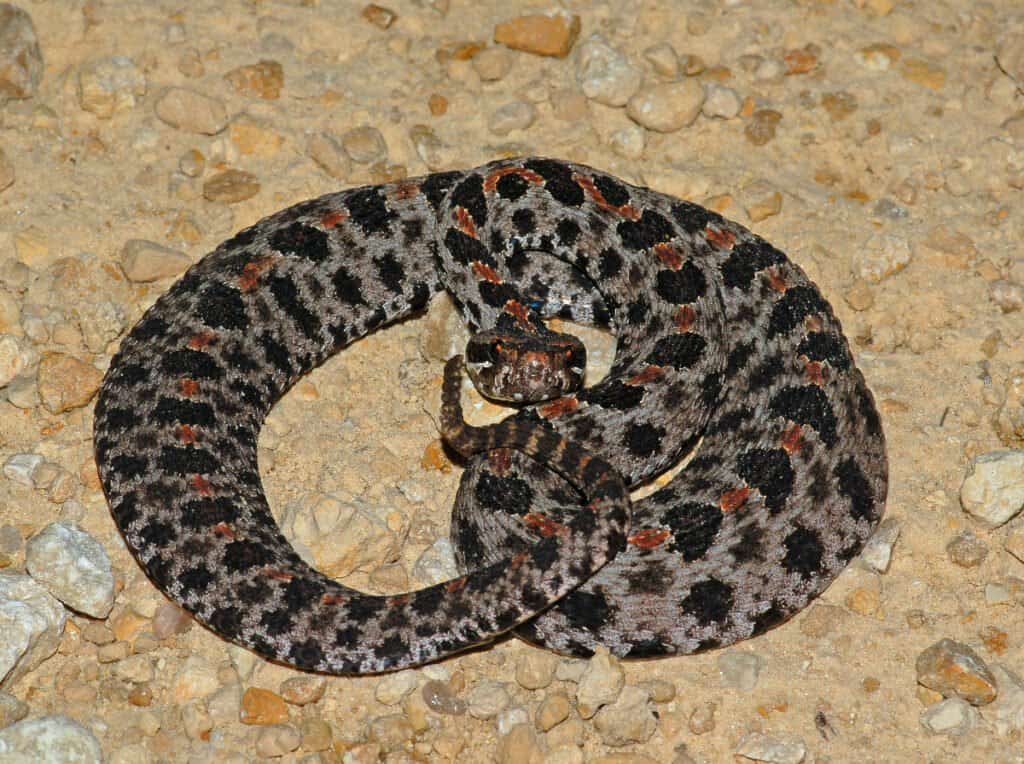
Pygmy Rattlesnakes are some of the smallest venomous snakes in the United States.
©Gerald A. DeBoer/Shutterstock.com
Just like other rattlesnakes, pygmy rattlesnakes are ovoviviparous and prey on small mammals, lizards, and smaller snakes. These small rattlers usually measure anywhere from 16 to 20 inches and weigh about 5.4 ounces — as adults.
Bites from the pygmy rattlesnake are very painful. However, in most cases, they are not fatal to humans because they can’t inject as much venom as bigger species. These snakes may lure their prey using their tails.
Pygmy rattlers are usually active in the summertime, so it is important to be able to identify them. They have orange or red dorsal stripes and a thick brownish-red to black line around their eye and jaw area. These snakes will usually announce their presence with a high-pitched buzzing sound.
Timber Rattlesnake
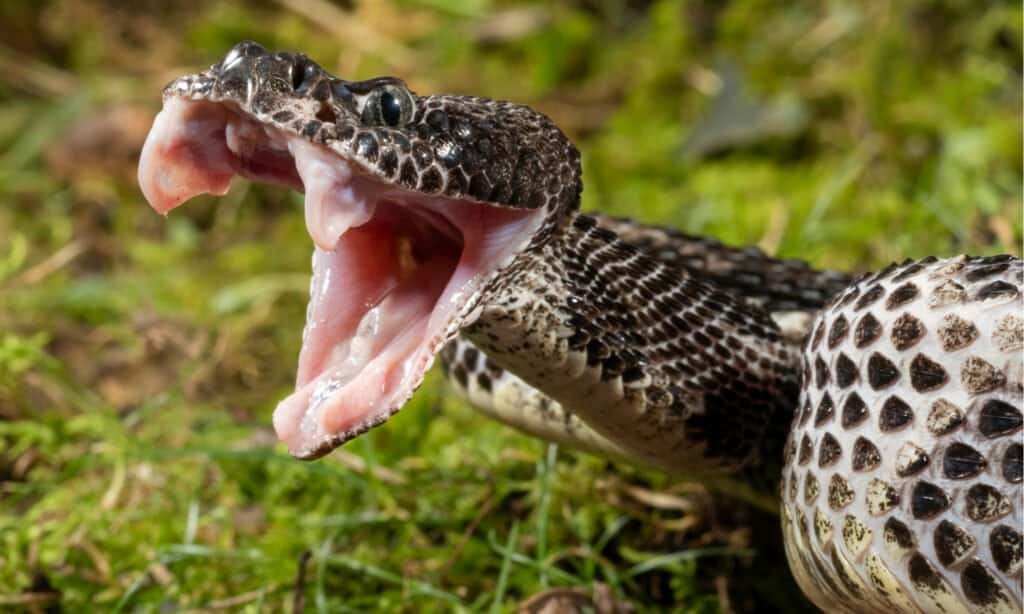
Timber rattlesnakes are expert climbers and have been spotted 80 feet up in trees.
©Joe McDonald/Shutterstock.com
The timber rattlesnake is another rattlesnake that you may encounter in North Carolina. Also known as the canebrake rattlesnake, these species are easy to identify. They usually have lighter olive or yellowish base colors with black v or m-shaped saddle markings but toward the last few inches of their bodies, they are black and have a rather large rattle.
Like most pit vipers, timber rattlesnakes have big chunky heads, large venom glands, and heat-sensing pits between their nostril and eye.
These snakes prey on shrews, chipmunks, and mice. The venom in their bites contains hemotoxins that affect cells and tissue. In humans, however, timber rattlesnake bites aren’t usually fatal — especially if you get treatment immediately. If you’ve been bitten by one, head to the nearest hospital. Antivenom is available for all pit vipers in North America.
Eastern Coral Snake

Eastern Coral snakes
are strikingly beautiful and equally deadly snakes found in North Carolina.
©iStock.com/JasonOndreicka
The eastern coral snake is gorgeous looking with beautiful scales. It is definitely one of the snakes with the coolest patterns in the world. Eastern coral snakes have distinctive red, yellow, and black rings all over their bodies. Usually, larger red and black rings are separated by thinner yellow rings.
However, these snakes are as beautiful as they are dangerous. Their venom contains potent neurotoxins that cause rapid paralysis and respiratory failure in their prey. Fortunately, they are relatively docile and only bite if directly threatened.
These are North America’s elapids — cobra cousins. Like their elapid cousins, coral snakes lay eggs. Although venomous, they spend a lot of their time in hiding and will try their best to avoid you.
Summary of 6 Venomous Snakes in North Carolina
| Venomous Snake | Toxicity | |
|---|---|---|
| 1 | Copperhead | Venom contain hemotoxins that temporarily damage tissues in the bite area |
| 2 | Cottonmouth | Venom contains hemotoxins that break down blood cells and stop blood from clotting, leading to hemorrhaging of the circulatory system |
| 3 | Eastern Diamondback Rattlesnake | Venom contains hemotoxins which damage tissues and kill red blood cells |
| 4 | Pygmy Rattlesnake | Cytotoxic venom, strongly hemorrhagic, and tissue-toxic (though it lacks neurotoxin) |
| 5 | Timber Rattlesnake | Venom contains hemotoxins that temporarily damage tissues in the bite area |
| 6 | Eastern Coral Snake | Venom contains potent neurotoxins that cause rapid paralysis and respiratory failure in their prey |
The photo featured at the top of this post is © Joe McDonald/Shutterstock.com
Discover the "Monster" Snake 5X Bigger than an Anaconda
Every day A-Z Animals sends out some of the most incredible facts in the world from our free newsletter. Want to discover the 10 most beautiful snakes in the world, a "snake island" where you're never more than 3 feet from danger, or a "monster" snake 5X larger than an anaconda? Then sign up right now and you'll start receiving our daily newsletter absolutely free.
Thank you for reading! Have some feedback for us? Contact the AZ Animals editorial team.






